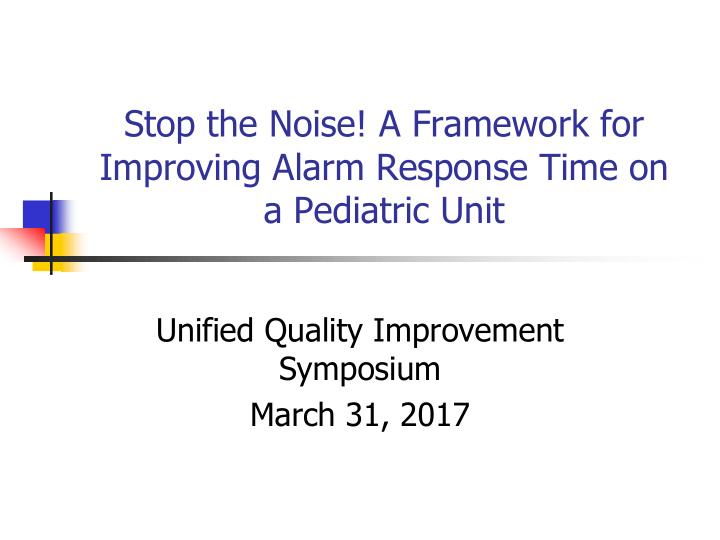



Stop the Noise! A Framework for Improving Alarm Response Time on a Pediatric Unit Unified Quality Improvement Symposium March 31, 2017
Introduction Alarm management has received increasing attention as a patient safety concern Frequent exposure to nonactionable alarms affects all institutions, especially pediatrics QI initiatives tailored to this population are needed to address this workforce and safety concern
Collaborative Team Members Ed Johnson, MD, Team Leader Katrina Raley, BSN, RN, CEN, 2 West Nurse Manager Mike Dunkerley, RN, CPN, 2 West Assistant Nurse Manager LaTasha Blount, Monitor Tech Jeanette Taylor, Monitor Tech Edward Johnson, 252 847 8322, johneoned@ecu.edu
AIM Statement with Numerical Goals The Aim Statement for my project was: 90% of red alarms on 2 west to be cleared by a healthcare provider within 3 minutes by 6 months
How Will We Know This Change Is An Improvement? Outcome measures included the number of actual red alarms during a twelve hour shift, and minutes between red alarm trigger to clearance by a provider 2 west uniquely employs monitor technicians as first line responders to red alarms Two monitor technicians collected data during their twelve hour shifts 2-3 times per week
Alarm Response Time 1:04 Baseline Data 0:57 Baseline Data 3 red alarms out of 11 cleared within 3 minutes (27%) 0:50 Time to Clearance (hours:minutes) 0:43 PDSA Cycle #2 PDSA Cycle #3 PDSA Cycle #1 0:36 0:28 0:21 0:14 0:07 0:00 8/18/2016 9/7/2016 9/27/2016 10/17/2016 11/6/2016 11/26/2016 12/16/2016 1/5/2017 1/25/2017 2/14/2017 Dates Red alarm Average Clearance Time
Improvement Strategies Employed PDSA cycle #1 – Nurse education at monthly staff meeting. PDSA cycle #2- Implementation of new guideline helping improve communication between nursing and monitor technicians PDSA cycle #3 – Implementation of guideline for which patients should be placed on monitors PDSA cycle changes occurred every 2-4 weeks
Red ed Alarm rm Proc ocess Ch Chart rt Patient placed Monitor on monitors discontinued Red alarm goes Response per off protocol Yes Monitor tech analyzes True rhythm red Monitor cleared alarm Notifies nurse No Clear alarm Notify charge nurse if no response from bedside nurse
Outcomes Percentage of Alarms Cleared 100 90 80 70 63 57 56 60 Percent (%) 50 40 27 30 20 10 0 September October December January Dates Percentage cleared Goal
Challenges Encountered in QI Process Participation from nursing staff Participation from medical staff Accurate data collection
Lessons Learned Through QI Efforts QI work is hard!! The key to a successful project is teamwork and collaboration Implementing a change is hard, but sustaining a change is harder Small changes in a system can lead to an improvement. I’m a believer now!!
Next Steps Finding a nursing champion Implementation of an electronic means of nursing notification from alarm management Finding a way to incorporate monitor utilization during the pediatric inpatient rotation
Recommend
More recommend